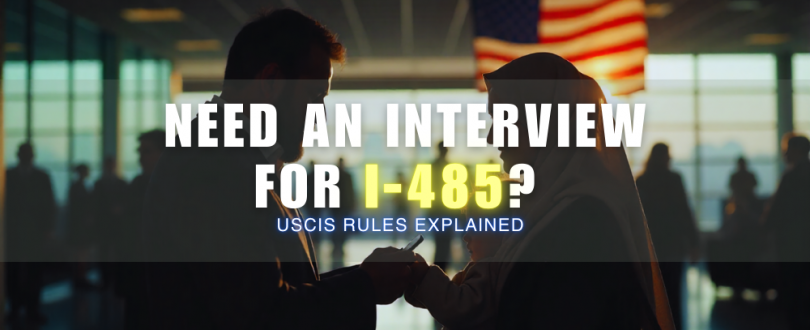
For many green card hopefuls, the Form I-485 interview feels like the most nerve-wracking part of the immigration process. The anticipation is understandable: an interview with a USCIS officer can make or break an application to adjust status to permanent residency. But here’s the million-dollar question: is an interview always required?
The answer is nuanced. While interviews are a standard part of most adjustment cases, USCIS does have the discretion to waive them under certain conditions. Let’s break down when you can expect an interview, why it matters, and how to prepare if you’re called in.
The Purpose of the I-485 Interview
At its core, the I-485 interview exists to give USCIS a chance to verify what’s on paper. Officers use this time to:
Authenticate the application and supporting documents.
Assess eligibility to ensure the applicant qualifies for permanent residency.
Evaluate relationship claims, particularly in marriage- or family-based cases.
Clarify discrepancies in immigration history or paperwork.
Think of the interview as USCIS’s way of double-checking that everything lines up—your story, your documents, and your eligibility.
Who Must Typically Attend an I-485 Interview
Not every applicant is treated the same way. Generally, these groups can expect an interview:
Family-based applicants: Marriage-based green cards almost always involve interviews, since proving the legitimacy of the relationship is central to the process.
Employment-based applicants: Once relatively rare, interviews for these cases are now increasingly common, especially when USCIS wants to confirm job details and employer sponsorship.
Diversity visa lottery winners: Interviews are part of the standard process to confirm identity and eligibility.
Humanitarian categories: Refugees and asylees adjusting status may also be interviewed.
It’s not just the primary applicant, either. Derivative beneficiaries—spouses and children included on the application—are also expected to attend.

When USCIS Waives the Interview
Here’s the silver lining: USCIS can waive interviews on a case-by-case basis. This usually happens when:
– The applicant’s record is clear, with no red flags or inconsistencies.
– The case falls into specific waiver categories, such as unmarried children of U.S. citizens or permanent residents under a certain age, or military personnel petitioners.
– The applicant has a medical condition or incapacitation preventing attendance.
For employment-based cases, waivers are more likely if the individual’s role and employer relationship are well-documented and straightforward. Still, nothing is automatic—waivers depend entirely on USCIS officer discretion and the strength of the applicant’s file.
What Happens During the I-485 Interview
If you do get scheduled for an interview, here’s what to expect.
Length: Typically 20–40 minutes, depending on case complexity.
Documents: Officers will review originals and copies of supporting paperwork.
Questions: These can range from the basics to more detailed checks:
– Biographical: confirming your personal information.
– Immigration history: verifying lawful entries, prior visas, and compliance.
– Relationship authenticity: especially in family-based cases.
– Employment verification: for work-based applicants, detailing job duties and employer sponsorship.
At the end of the session, the officer may approve your application on the spot, request additional evidence, or mark the case for further review.
Preparing for the Interview
Preparation goes a long way in easing nerves. Here’s a checklist:
Bring the I-485 interview notice.
Carry a government-issued photo ID (passport, driver’s license).
Pack originals and copies of all supporting evidence—employment records, relationship documents, tax returns, and more.
Be ready to answer questions honestly and consistently, sticking to what’s in your application.
If you feel uncertain, remember: you can bring an attorney to represent you, and an interpreter if English isn’t your first language. Both ensure clarity and prevent miscommunication.
Outcomes After the Interview
The interview can end in several ways:
Approval: Some applicants get the green light immediately, with their green card arriving weeks later.
Request for Evidence (RFE): If something is missing or unclear, USCIS may ask for additional documents.
Background checks or administrative processing: Certain cases require more time for security reviews.
Denial: Rare but possible if eligibility criteria aren’t met. Denials may be appealed or refiled in some circumstances.
Conclusion
So, does the I-485 require an interview? For most applicants, yes—but not always. USCIS uses interviews as a safeguard to ensure that applications are authentic and applicants are eligible. Still, waivers do exist, particularly in clean-cut employment-based or low-risk cases.
If you’re called in, think of the interview less as a trial and more as a confirmation. Be honest, be consistent, and come prepared with your documents.
For guidance, explore resources like the USCIS Policy Manual on Interviews, GovAssist’s 2025 I-485 Interview Guide, and CitizenPath’s preparation tips. With the right preparation, the interview doesn’t have to be daunting—it can be the final step toward a new life in the United States.

